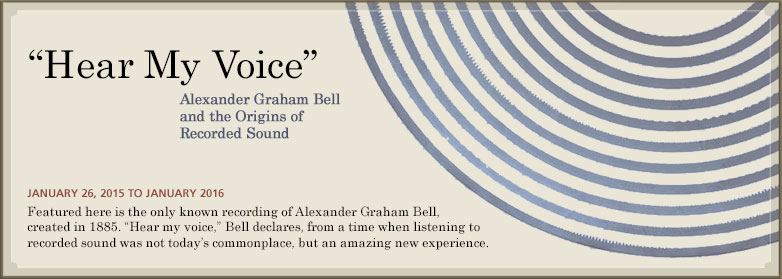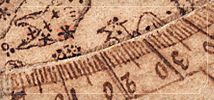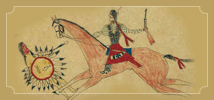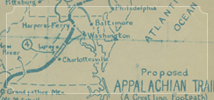Exhibitions

Hear My Voice
January 26 to October 25, 2015
Featured here is the only known recording of Alexander Graham Bell, created in 1885. “Hear my voice,” Bell declares, from a time when listening to recorded sound was not today’s commonplace, but an amazing new experience.
Past Exhibitions
-

May 16 - January 4, 2015
Making a Modern Museum
Explore the origins of the National Museum of American History (named the Museum of History and Technology until 1980) and consider what those beginnings mean for the Museum today and into the future.

January 24 - May 4, 2014
Camilla's Purse
The story of America includes the history of those who have lived through extraordinary circumstances. Camilla Gottlieb was a Holocaust survivor. Her purse, discovered by her family after her death, contained letters and papers that trace her trials and triumphs. These documents reveal a compelling story of imprisonment, the pain of separation, and, through emigration, a joyful reunion with family in America.

June 28, 2013 - January 12, 2014
Little Golden Books
The National Museum of American History is home to nearly 500 of the original drawings from Little Golden Books. They represent a commercial bonanza that transformed the children’s book from a rare, treasured object to a part of every American middleclass home.

September 27, 2012 - May 12, 2013
Not Lost in Translation: the Life of Clotilde Arias
This exhibition is about Clotilde Arias, a Peruvian immigrant who came to New York City in 1923 at age twenty-two to study music. Decades later she translated the national anthem into the official Spanish version at the request of the U.S. government. Arias died in 1959 in Manhattan at age fifty-eight.

November 11, 2011 - July 15, 2012
Thomas Jefferson's Bible
The Life and Morals of Jesus of Nazareth, created by Thomas Jefferson in 1820, is an 84-page assemblage of passages from the first four books of the New Testament. It was the work of Jefferson's own hands and a product of his extraordinary mind. It was a personal exercise in understanding Jesus's moral teachings separated from religious doctrine. The resulting work represented a meeting of Enlightenment thought and Christian tradition as imagined by one of the great thinkers of the Revolutionary Era.

August 12 - October 28, 2011
Have you heard the one about...?
The Phyllis Diller Gag FileIn the history of American comedy, Phyllis Diller is a unique trailblazer. Her style of humor debunked the idealization of women as wives, mothers, and homemakers. In doing so, it treated themes remarkably similar to the perspectives of the burgeoning feminist movement of the 1950s and 1960s. Similarly, she broke the gender barrier that previously existed in stand-up comedy, a field dominated by men.

April 22 - July 29, 2011
So Much Need of Service:
The Diary of a Civil War NurseIn April 1863, two years after the outbreak of the Civil War, Amanda Akin (1827– 1911) journeyed from her home in Quaker Hill, New York, to serve as a nurse at Armory Square Hospital in Washington, D.C. She was one of several million men and women who left their families and communities behind to contribute to the war effort. Many departed to fight, while others took on civilian assignments to support the military campaigns.
Akin and other hospital workers were often eager to share their experiences with distant friends and family, and to preserve memories of the people and events that defined their new situations. Letters, diaries, and published accounts helped fill this need. Today, these documents provide a glimpse into the lives of those who served and a touching record of the challenges of hospital life.
December 17, 2010 - April 8, 2011
A Gateway to the 19th Century:
The William Steinway Diary, 1861–1896Beginning eight days after the first shots of the American Civil War were fired and three days before his wedding, William Steinway’s remarkable diary bears witness to one of the most dynamic periods in American history.
Over 36 years, nine volumes, and more than 2,500 pages, William Steinway’s diary records a newlywed’s exuberance, his observations of a country at war, and his emergence as a leader in the cultural, economic, political, and physical development of New York City. In near-daily entries until his death in 1896, William details the period’s financial panics and labor turmoil, rise of the German immigrant class, growing sophistication of transportation, and fierce piano manufacturing wars in which his family firm, Steinway & Sons, was a major player. A proud member of New York’s German American community, William was at once an immigrant success story and an ambitious industrialist. The exhibition follows Steinway’s growth from witness to participant in history through select diary passages, Steinway family photographs, maps, and advertisements that bring alive the fear and chaos of the 1863 Civil War Draft Riots and his hands-on role in the creation of the New York City subway and the company town of Steinway in modern-day Astoria, Queens. The display also provides a behind-the-scenes look at work on the William Steinway Diary Project—one of the Smithsonian’s largest and longest-running volunteer research efforts—whose roster of more than 100 highly qualified volunteers included William’s grandson, Diary donor Henry Ziegler Steinway, who was a central part of the Diary Project until his death in 2008. The exhibition opening is timed to coincide with the Diary Project’s launch of The William Steinway Diary Web Site, the first installment of the Museum’s long-term project to create a fully-annotated online edition of the Diary.
May 25 – December 5, 2010
The Cosmos in Miniature: the remarkable star map of Simeon De Witt
The small object featured in this exhibition is the oldest surviving Anglo-American star map. It was made in 1780 by Simeon De Witt, a surveyor for George Washington and the Continental army. The map shows the stars visible from De Witt’s post in New Jersey. Drawing such a map, as De Witt himself later said, fostered an appreciation of “the ever shifting scenery of the skies and all the gorgeous drapery of heaven.”

February 26 – May 7, 2010
A Letter from George Washington, November 30, 1785
On November 30, 1785 George Washington wrote to David Stuart, a trusted associate and stepfather to Washington’s grandchildren.
“If we consider ourselves, or wish to be considered by Others as a United people, why not adopt the measures that are characteristic of it—Act as a Nation. . .”
Through an examination of this letter the exhibition reveals Washington's active role in the political debates of the day leading up to the Constitutional Convention. The letter remained in the Stuart family until last year, when through a donation of Dr. Peter Buck, the Smithsonian’s National Museum of American History acquired the document. This is the first time this letter was on public display.

November 13, 2009 – February 5, 2010
Keeping History: Plains Indian Ledger Drawings
History can be kept and revealed in many ways. This exhibition features ledger drawings, a style of visual history, developed by Native warriors from the Northern and Southern Plains in the late 19th century. The visual style of the ledger drawing was developed out of a fusion of older documentary traditions, such as petroglyphs (on rock), pictographs (on bark and hide), and the newer media of ink, lead, colored pencil, paper and muslin. These drawings serve as valuable, first-hand biographical documentation of the personal and cultural histories of a Native people. This new synthesis of representational art told the stories of battles, bravery, and loss. They told of Native lives as hunters and horsemen of the Plains, and of the rich, ceremonial and cultural life of a people–a way of life much threatened by soldiers and settlers flooding into traditional lands. This exhibit will feature drawings, from ledger books, by some of those combatants in wars for sovereignty over the Plains, some of them made while their Native makers were imprisoned for their actions in those struggles. The exhibit will also give examples of the influence of these drawings on contemporary Native art and history.

July 10 – October 11, 2009
Earl Shaffer and the Appalachian Trail
Earl Shaffer was the first person to walk the entire Appalachian Trail in one continuous hike. Shaffer had no expert advice, no previous footsteps to follow, or even guidebooks to help him. At the time, experts on the Appalachian Trail believed that a hike of the entire Trail was impossible. Shaffer started his walk in April 1948 at Mount Oglethorpe, Georgia, and completed the Trail four months later at Maine’s Mount Katahdin. Shaffer kept a diary, along with photographs taken along the way, to prove to skeptics that he had really accomplished what he claimed. This exhibition features photographs taken along the trail, Shaffer’s diary from the 1948 hike, and maps he used. The exhibition also covers the conception and development of the Appalachian Trail and its larger cultural and environmental impact.

April 4 – June 28, 2009
Duke Ellington and Billy Strayhorn: Jazz Composers
Since the earliest days of jazz, composers have worked, sometimes off stage and behind the scenes, to help create a repertory for the performers to play. Two of the greatest composers of jazz were Duke Ellington (1899-1974) and Billy Strayhorn (1915-1967), and they collaborated on hundreds of works. This exhibition examined two jazz standards, each the most-recorded piece by its composer(s): Caravan, composed in 1936 by Duke Ellington and Juan Tizol, and Take the “A” Train, composed in 1941 by Billy Strayhorn. The exhibition opening was timed to coincide with Jazz Appreciation Month in April 2009.

January 16 – March 22, 2009
America’s New Birth of Freedom
As part of its Abraham Lincoln commemoration, the Museum hosted an exhibition of ten rare and important documents from the Abraham Lincoln Presidential Library and Museum in Springfield, Ill. The display included a signed copy of the Emancipation Proclamation and letters expressing Lincoln's views toward emancipation and the conclusion of the Civil War. These documents have become the cornerstone of current thinking on Lincoln and his legacy. Included in the exhibition was Lincoln's letter to long-time friend James C. Conkling in which he makes his forceful defense of the Emancipation Proclamation and his letter to Francis Blair, Lincoln's unofficial conduit to Confederate President Jefferson Davis, on his unwavering demands for peace.

November 21, 2008 – January 11, 2009
The Gettysburg Address
President Abraham Lincoln's short address at the Gettysburg, Pennsylvania, battlefield is one of the most eloquent political speeches in American history. Its inspiring message remains as meaningful today as when first delivered at the dedication of the Soldiers National Cemetery on November 19, 1863. Read about the history of the Address, the White House copy of the document, and watch a video about the restoration of the Lincoln Bedroom, where the artifact is normally housed.